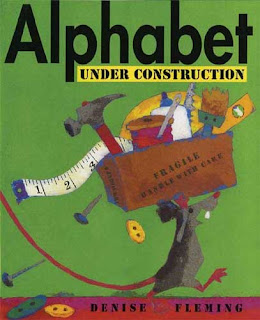Sandy at Unpacking the POWER of Picture Books starts us off with a bang! All in one post, she highlights the picture books A Dance like Starlight: One Ballerina's Dream, Bea at Ballet, On Your Toes: A Ballet ABC, and Oliver Button is a Sissy. Plus, she includes links to other reviews of A Dance Like Starlight, as well as to an interview with the author and illustrator of Flora and the Flamingo. Thanks to Cathy at Bildebok from Cathy Ballou Mealey for letting me know about this post!
A Dance Like Starlight was a popular book in April, especially given that April was National Poetry Month and the book is written so poetically by author Kristy Dempsey. Rhapsody in Books shares a review of the book, including several passages of text and several stunning images by illustrator Floyd Cooper.
In April, Giselle at Kids Yoga Stories celebrated picture books by author and illustrator Denise Fleming. In addition to listing seven of her favorite books by Fleming, Giselle provides yoga, movement, and counting ideas to go with Count!, In the Tall, Tall Grass, and In the Small, Small Pond.
The April Book to Boogie post at The Library as Incubator Project features guest blogger Jill Homan Randall, who provides movement ideas to go with the picture book Dance with Me by Charles R. Smith Jr. and Noah J. Zones. Short but spirited, the post is sure to inspire you to integrate this book into a lively story time!
Kathleen at Wild Things Yoga shares a yoga lesson plan for first and second graders based on the award-winning picture book biography The Man Who Walked Between the Towers. The lesson plan focuses on balance, perseverance, self-awareness, and risk-taking -- concepts that are also explored in the book, which tells the story of Philippe Petite, who walked along a wire between the twin towers of the World Trade Center in 1974. The post also provides links to a slideshow, news story, and mini-documentary about this amazing story!
If you love the character Gerald from the picture book Giraffes Can't Dance, you'll love Jayne's April post at ABCs of Reading. The post explores how you can work on the reading comprehension strategy of "making connections" through drama and creative movement, such as by having students travel through the story from Gerald's perspective. For example, "Try to run around, but buckle at the knees. What are your feelings when you fall?" This creative and insightful post also contains a link to an art lesson based on Giraffes Can't Dance...and more!
In her monthly roundup at Chapter Book Explorer, Amy features Five, Six, Seven, Nate! by Tim Federle. A sequel to Federle's Better Nate than Ever, this new chapter book continues Nate's journey to make it big on Broadway. "Take another hilarious and touch ride with Nate Foster as he learns to live in the Big Apple, masters his choreography, has his first kiss, and saves the show!" says Amy.













Oh wow! Denise Fleming is there? I am a huge fan of her beautiful art. I have all her books at my studio for inspiration!
Excellent tips! They make total sense to my art side AND my teacher side. I also prefer a lot to a dot of glue - get real other teachers, a dot is not going to make it stick!!! Plus, it's more fun to peel that layer of glue off and pretend it's skin ... :)
She's here, Laura! She's fantastic.
Patrick, I'm so glad you are exposing the hidden world of teachers who like glue.